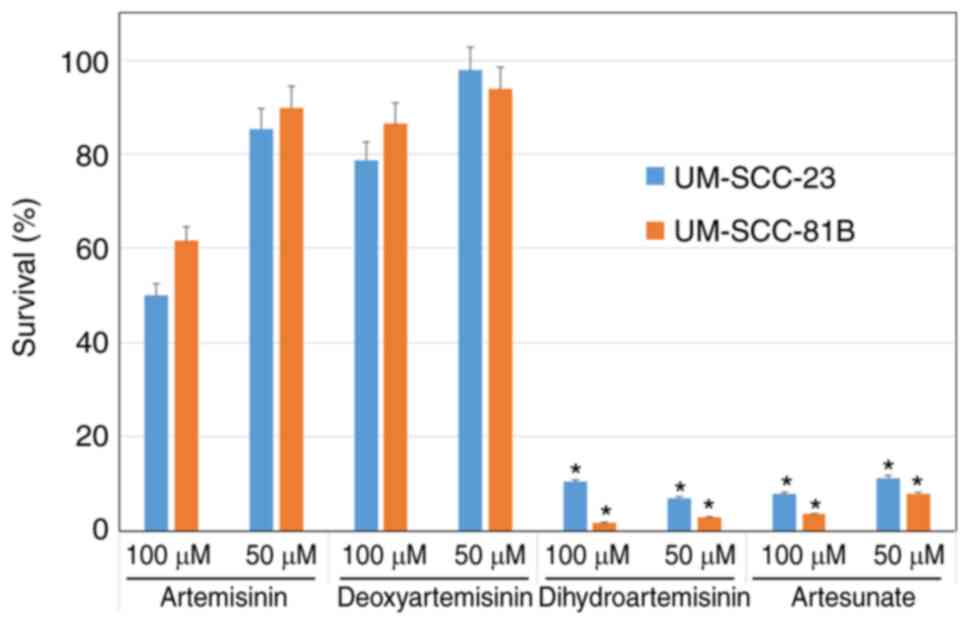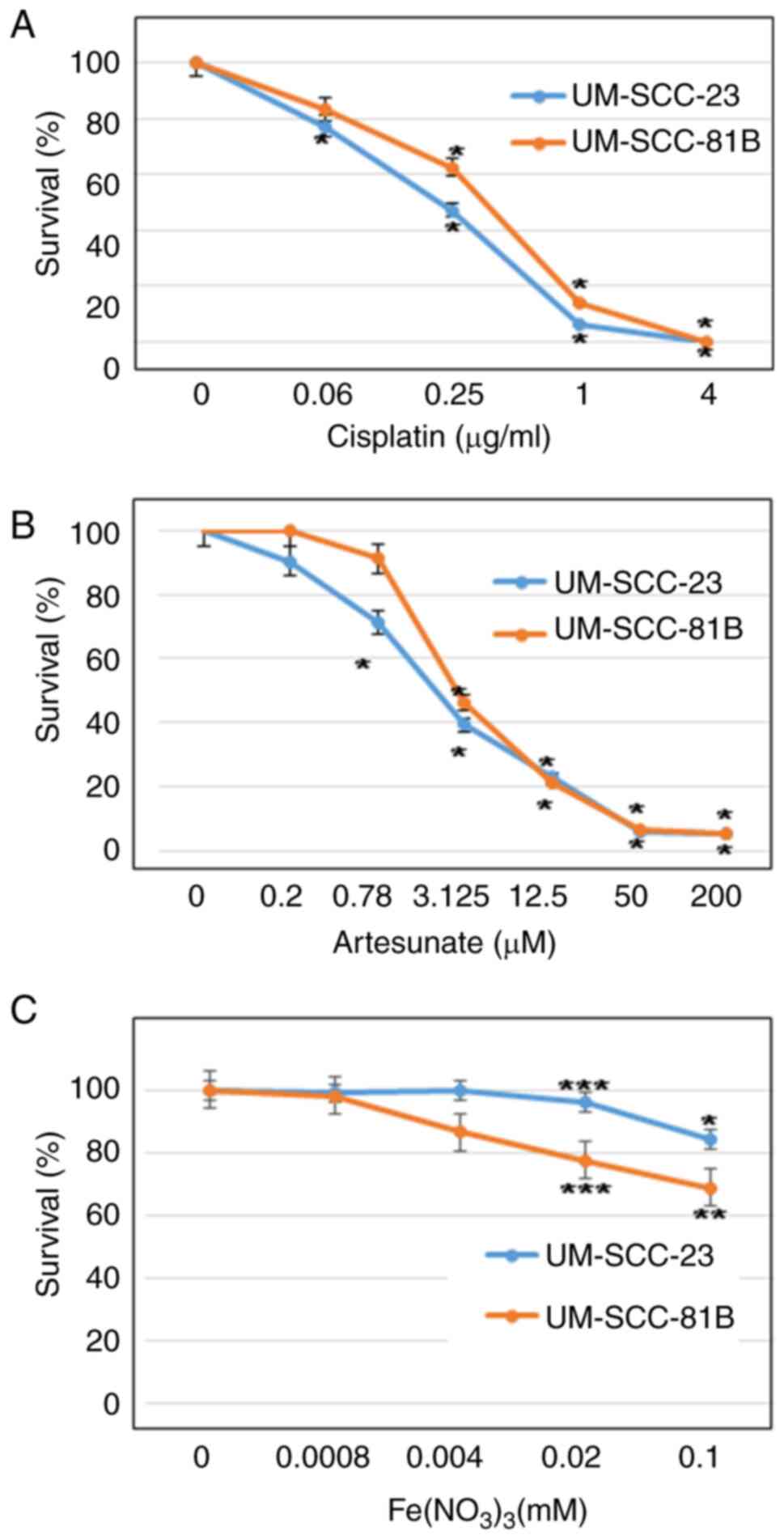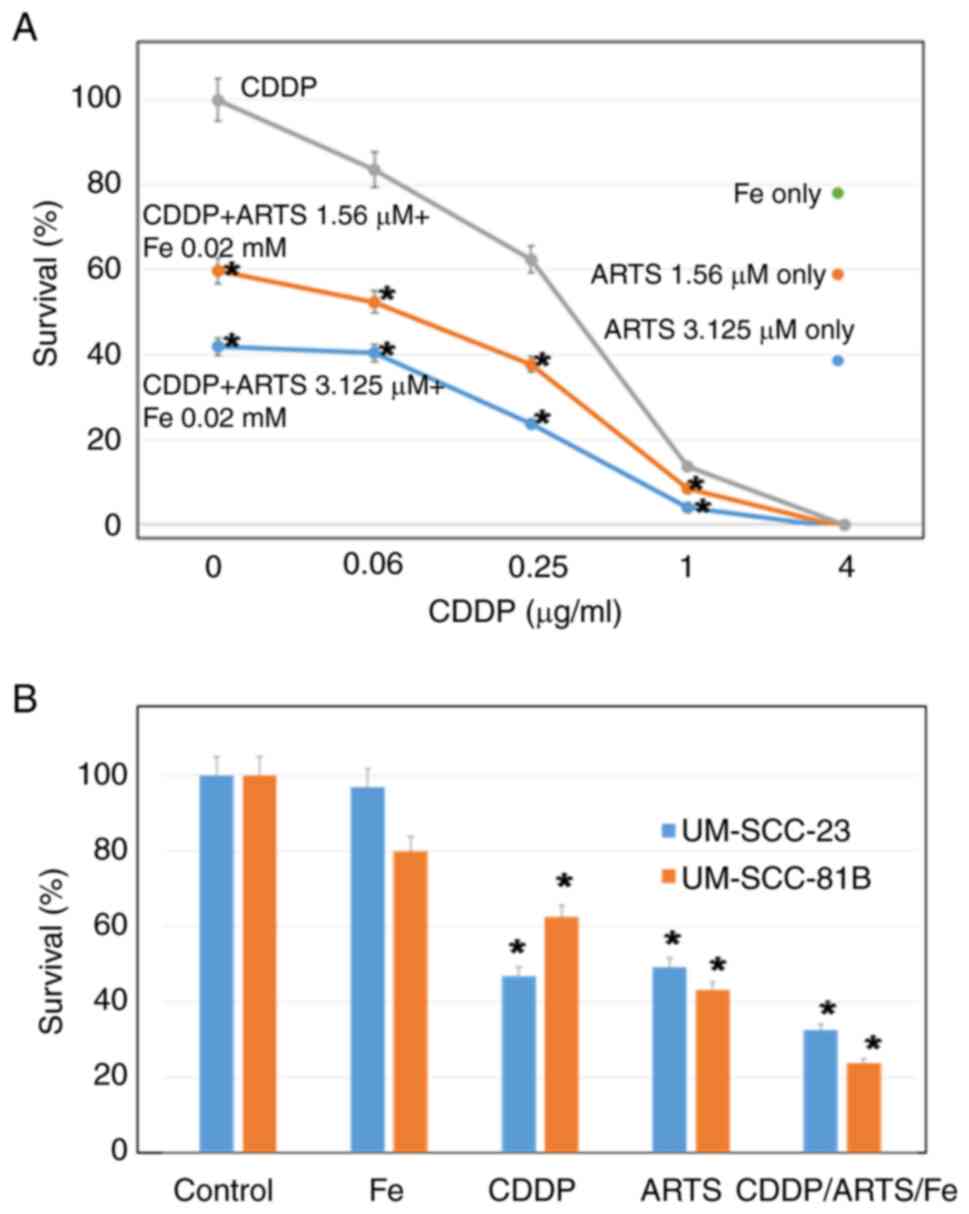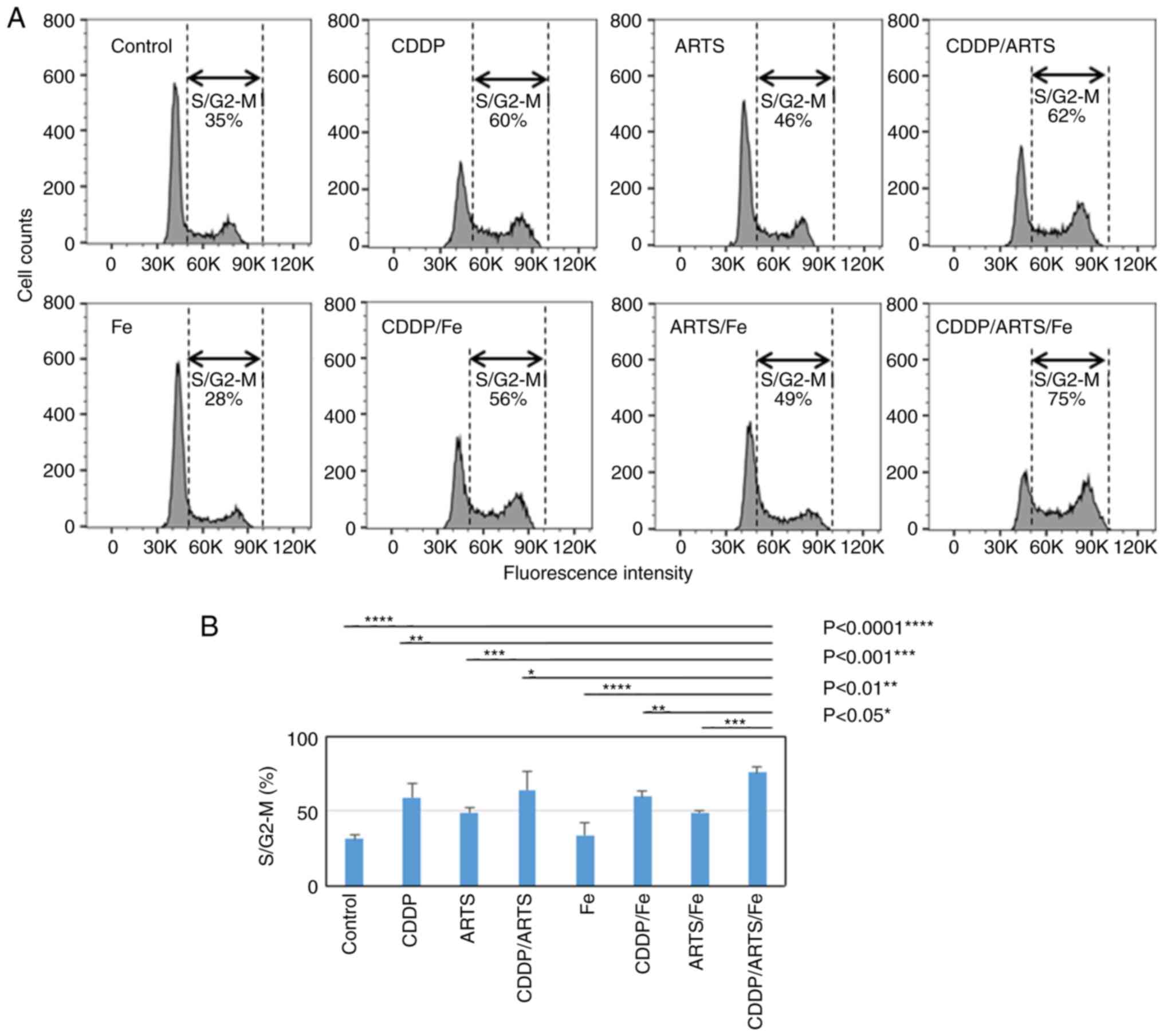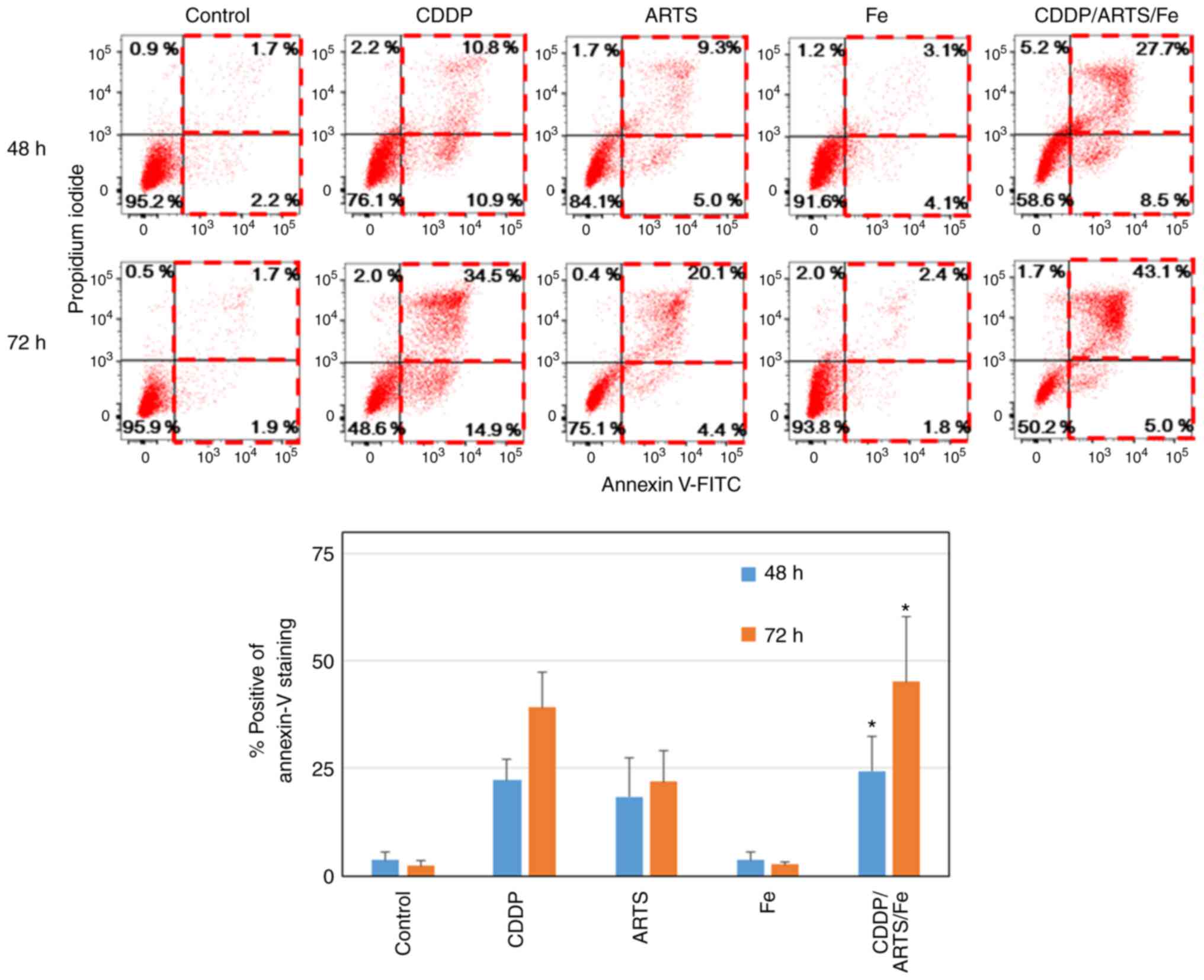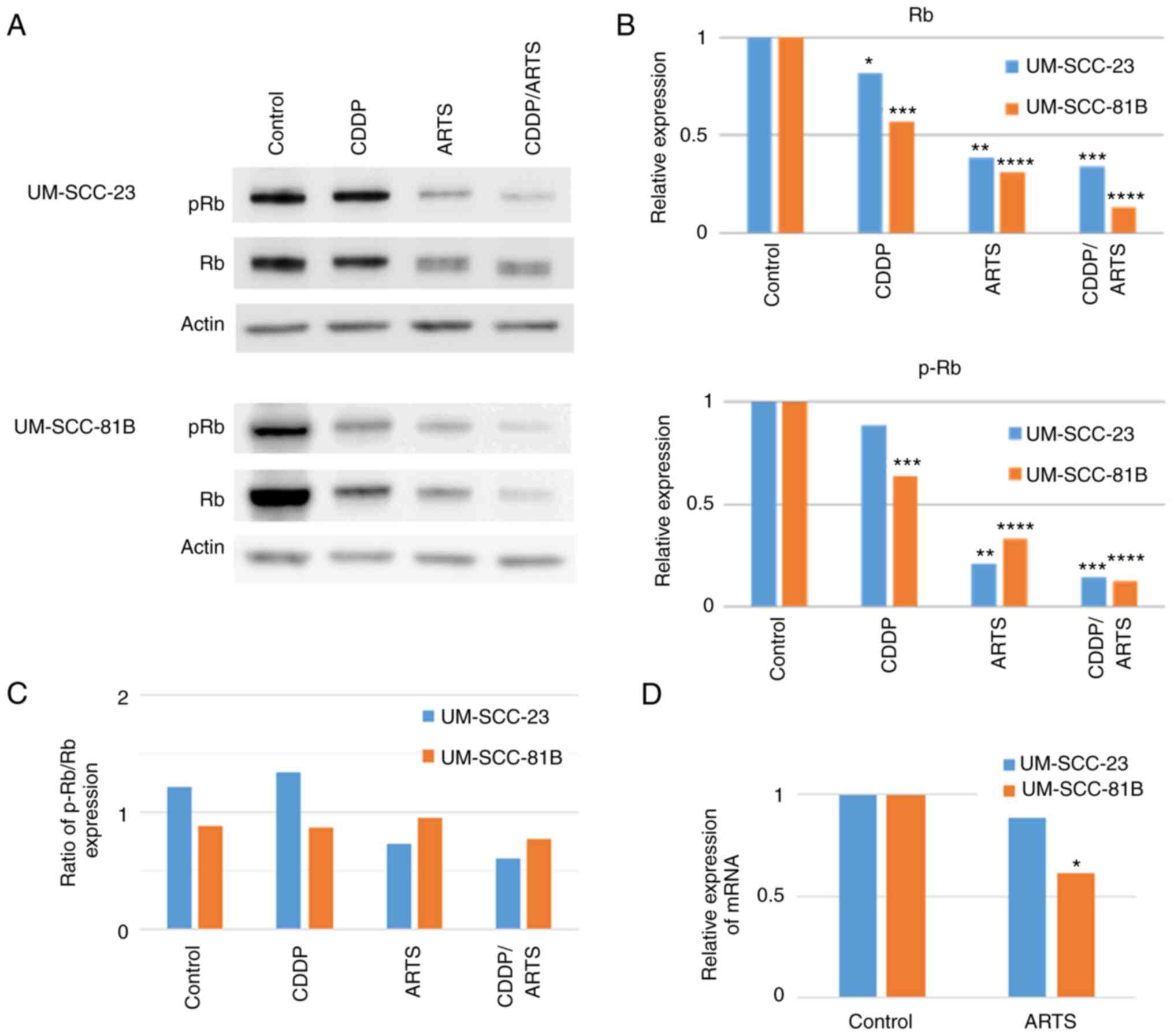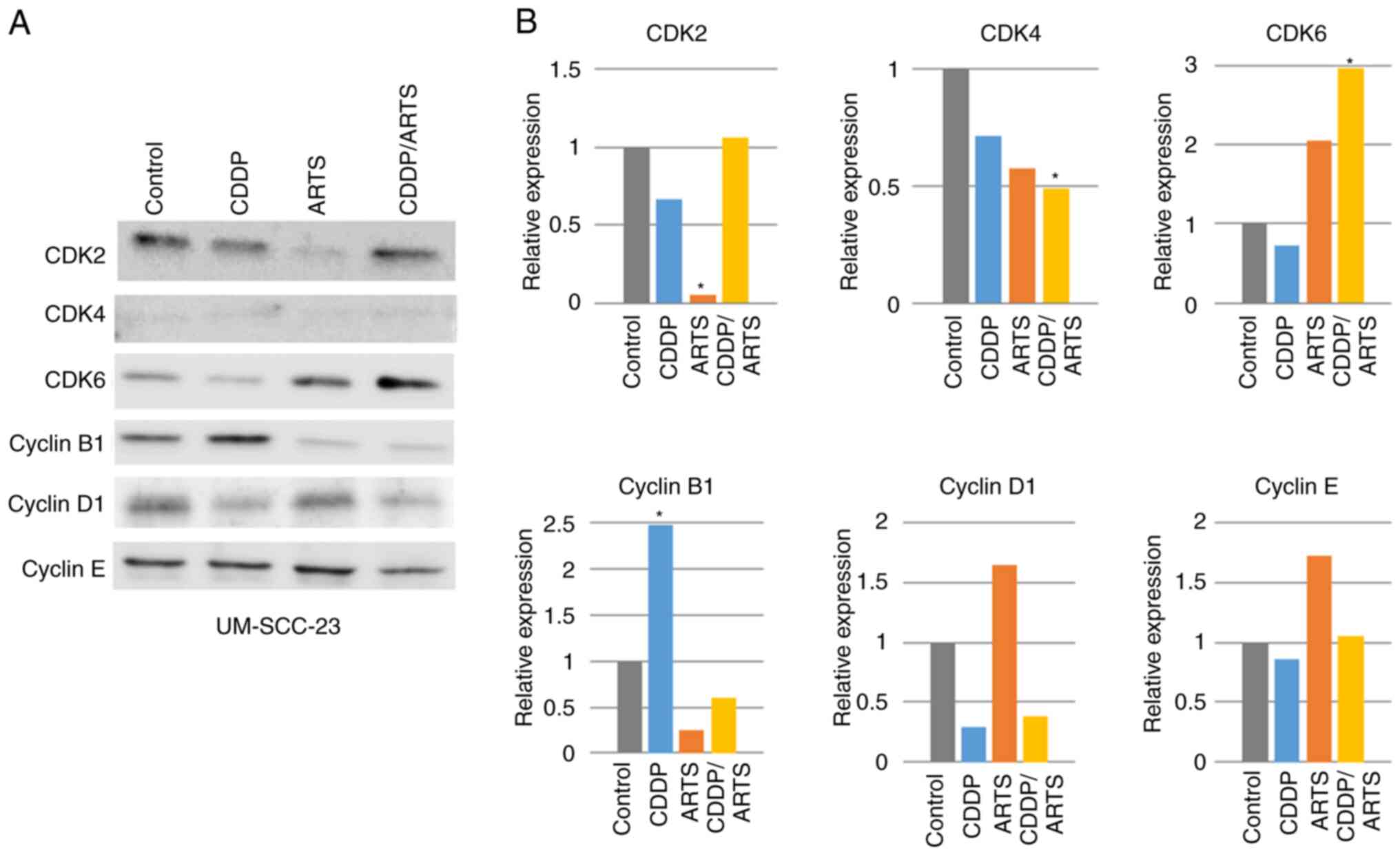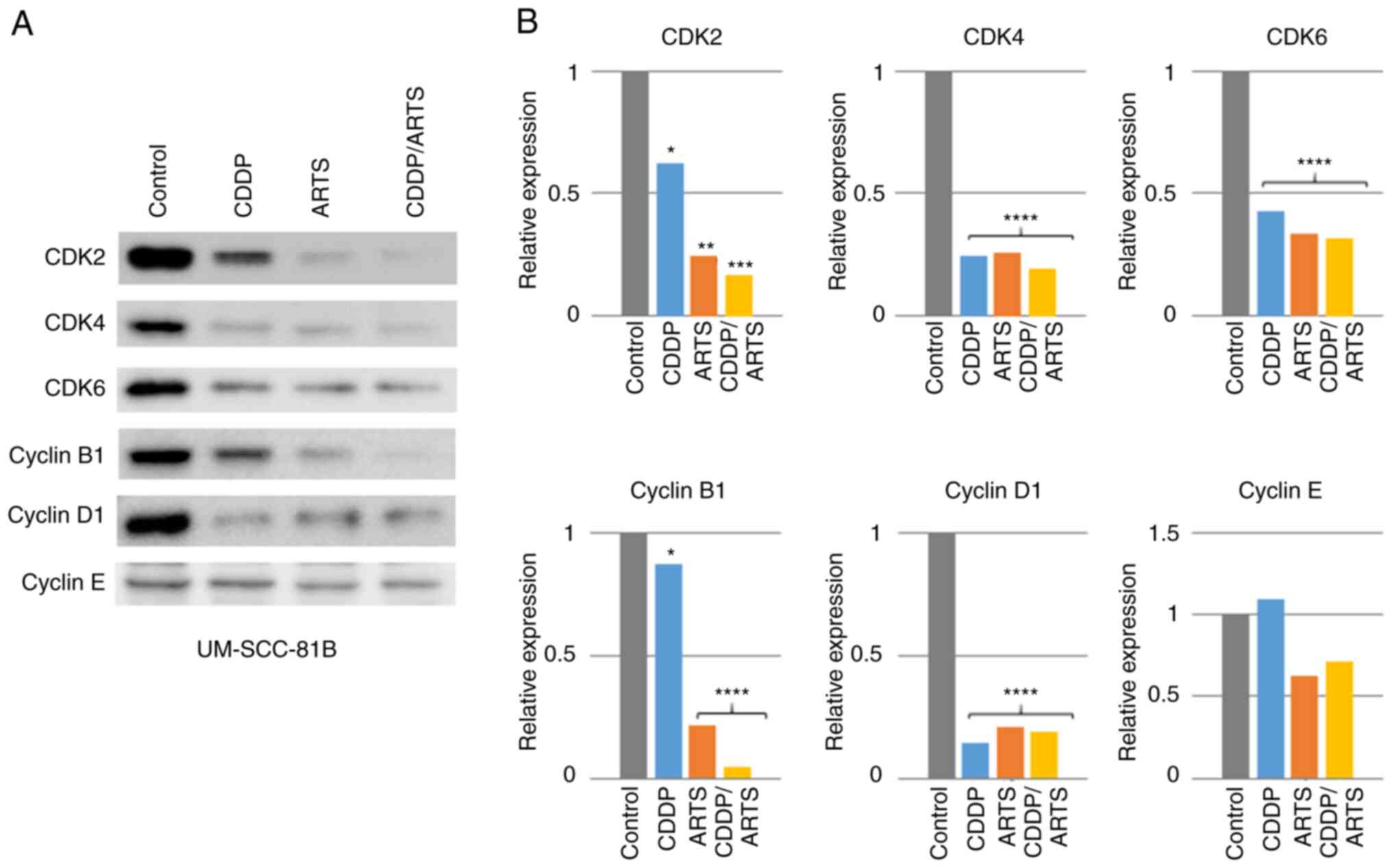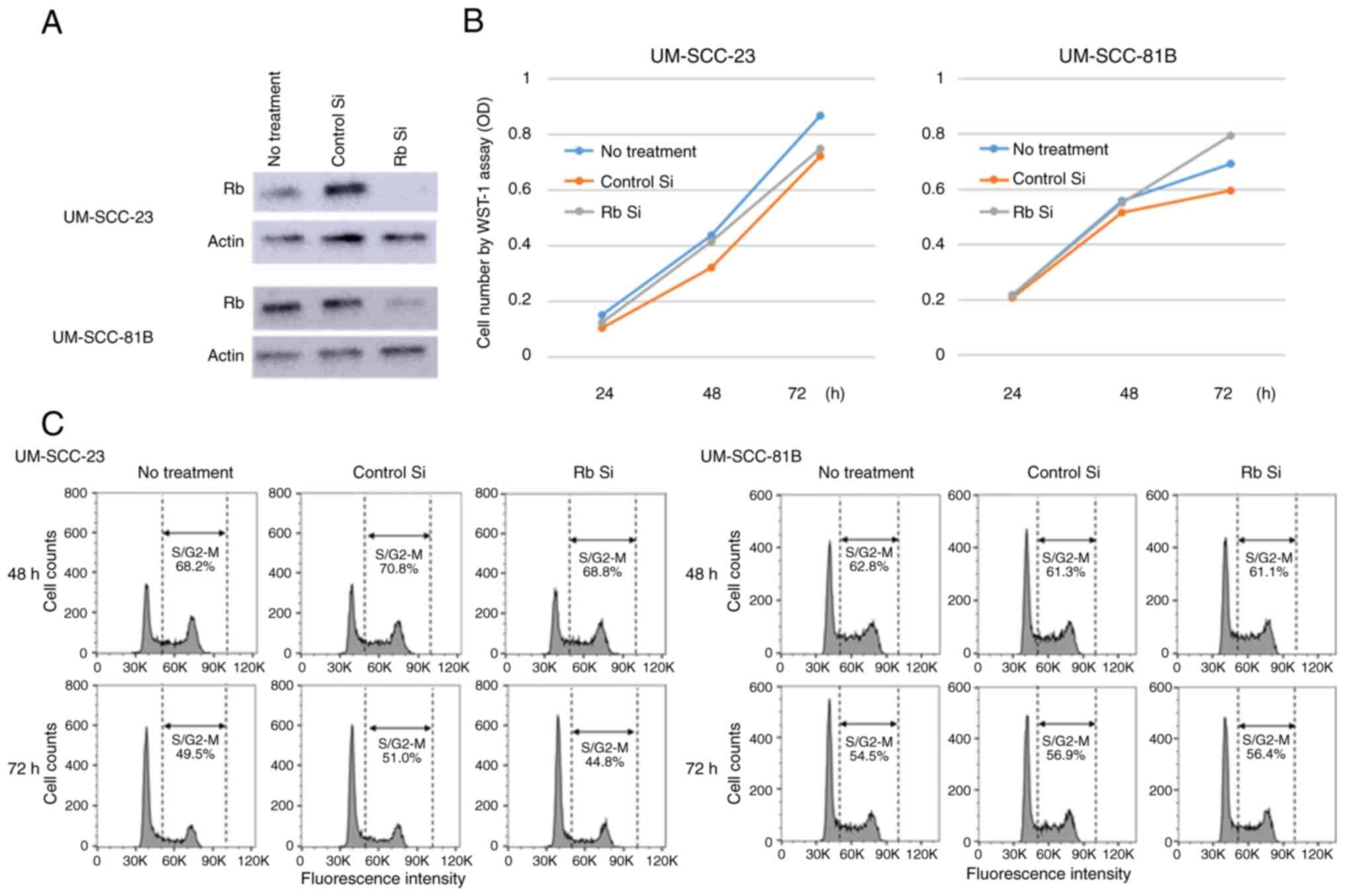Artesunate and cisplatin synergistically inhibit HNSCC cell growth and promote apoptosis with artesunate‑induced decreases in Rb and phosphorylated Rb levels
- Authors:
- Published online on: June 19, 2023 https://doi.org/10.3892/or.2023.8591
- Article Number: 154
-
Copyright: © Okamoto et al. This is an open access article distributed under the terms of Creative Commons Attribution License.
Abstract
Introduction
In 2018, head and neck cancers accounted for 8% of all cancers (~1.45 million individuals) and 5% of all cancer-related deaths (~500,000 individuals) according to analysis of 39 cancer types in 185 countries, and the number of cases is increasing annually (1). The main type of head and neck cancer is squamous cell carcinoma, and the standard treatments consist of chemotherapy, radiotherapy and surgery. For chemotherapy, cisplatin is a key drug, either as a single agent or in combination with other drugs (2,3).
The standard dose of cisplatin as a single agent is 80–100 mg/m2, but the response rate is only 25–50% (3,4). In addition, cisplatin should not be administered at the standard dose to patients with renal dysfunction (5). Thus, there is still no standard treatment for head and neck squamous cell carcinoma (HNSCC) in patients with renal dysfunction, and thus it is necessary to develop new treatments. Candidate therapies include antimalarial drugs such as artemisinin, a type of Chinese herbal medicine extracted from the wormwood plant [Artemisia annua (A. annua)]. Artemisinin is considered to be less toxic than other antimalarial drugs, and artesunate, a derivative of artemisinin with enhanced effects, is currently used for the treatment of malaria (6). Previously, artemisinin derivatives have been studied for their application to various human diseases (7). For example, Sun et al (8) reported that artemisinin and its derivatives exert antitumor effects on mouse leukemia cell lines and human hepatoma cell lines. Since then, the antitumor effects of artemisinin and its derivatives have been examined on various tumors (9,10). Previously, it has been reported that artesunate has antitumor effects (11). Although the combined effect of artesunate with other chemotherapy agents has been demonstrated in glioma and liver cancer (12,13), its antitumor effect in head and neck cancer has been reported only by Roh et al (14). This antitumor activity is reported to exert anti-proliferative effects through the following mechanisms: i) By inducing G1-phase arrest via upregulation of p16 protein expression and downregulation of CDK4 and cyclin D1 expression, as well as downregulation of ERK1/2 in GBC-SD and NOZ gallbladder cancer cell lines (15); ii) by inducing cell apoptosis and inhibiting cell proliferation in human acute promyelocyte leukemia HL-60 cells and acute myeloid leukemia KG1a cells via suppression of the MEK/ERK and PI3K/Akt pathways (16); iii) by reducing angiogenesis in the highly angiogenic KS-IMM cell line derived from Kaposi's sarcoma (17) and iv) by enhancing the radiosensitivity of U373MG cells through increased ROS generation (18). It has also been reported that artesunate affects various signal transduction pathways (including the Wnt/catenin pathway in RAW 264.7 murine macrophages, HT-29 colorectal cancer and A431 epidermoid cancer; the AMPK pathway in SHSY5Y neuroblastoma; metastatic pathways in RAW 264.7 macrophages, in H1395, A549, LXF289, H460, Calu3, and H1299 lung cancer, and in CaSki and HeLa cervical cancer) and signal transducers (including NF-κB in HT-1080 fibrosarcoma; MYC/MAX in 39 human cell lines derived from the colon, non-small cell lung cancer, and ovarian cancer; AP-1 in H1299 cells lung cancer; CREBP in RAW 264.7 macrophages; mTOR in Rh30 and RD rhabdomyosarcoma and in SHSY5Y neuroblastoma) (19–21).
However, the details remain unclear (20–22). In the present study, the antitumor effects of artesunate combined with cisplatin and iron in HNSCC cell lines were confirmed. Certain of the effects of this combined treatment on the expression of molecules related to cell proliferation were also clarified.
Materials and methods
Cell lines
In the present study, the HNSCC-derived UM-SCC-23 and UM-SCC-81B cell lines (a kind gift from Dr Thomas E. Carey, University of Michigan, Ann Arbor, MI) were used (22). The cells were maintained in RPMI-1640 medium containing 1% Pen-Strep solution (10,000 U/ml penicillin and 10,000 µg/ml streptomycin; Thermo Fisher Scientific, Inc.) and 10% fetal bovine serum (HyClone; Cytiva) at 37°C in an atmosphere containing 5% CO2 under humidified conditions.
Cell viability assay
The drugs used were artemisinin (CAS RN®: 63968-64-9; cat. no. A2118; Tokyo Chemical Industry Co., Ltd.), deoxyartemisinin (CAS RN®: 72826-63-2; cat. no. D232150; Toronto Research Chemicals), dihydroartemisinin (CAS RN®: 81496-82-4, cat. no. D3793; Tokyo Chemical Industry Co., Ltd.), artesunate (CAS RN®: 88495-63-0, cat. no. A2191; Tokyo Chemical Industry Co., Ltd.), and cisplatin (Randa Injection; Nippon Kayaku Co., Ltd.). Artemisinin and its derivatives are poorly soluble in water; thus they were dissolved in dimethyl sulfoxide (cat. no. D8418; Sigma-Aldrich; Merck KGaA).
Cell viability was measured with a WST-1 assay (Cell Counting Kit-8; Dojindo Laboratories, Inc.) after incubating each cell line with artemisinin and its derivatives (0.2–200 µM), cisplatin (0.6–4 µg/ml) and iron (0.0008-0.1 mM). UM-SCC-23 and UM-SCC-81B cells were seeded at 1.7×103 and 1.0×103 cells/well, respectively, in 96-well flat-bottom plates (cat. no. 353072; Corning, Inc.). The following day, each drug was added to each well and the cells were cultured further. At 72 h after drug administration, 10 µl of the WST-1 reagent was added and the cells were incubated for another 3 h. The color that developed after agitation was measured with a microplate reader (iMark; Bio-Rad Laboratories, Inc.) at the main wavelength of 450 nm and the secondary wavelength of 650 nm to measure cell viability (23). The following formula was used to calculate the percentage of survival: cell viability (%)=[(As-Ab)/(Ac-Ab)] ×100 [As, absorbance of the sample (wells containing cells, test substance, and WST-1 solution); Ac, absorbance of negative control (wells containing cells and WST-1 solution without test substance); Ab, blank absorbance (no cells, wells with medium, and WST-1 solution)].
Cell cycle and apoptosis analyses by flow cytometry
For cell cycle analysis, UM-SCC-23 and UM-SCC-81B cells were seeded at 0.5×105 and 0.3×105 cells/well, respectively, on six-well plates (353046; Corning, Inc.). The next day, artesunate (3.125 or 12.5 µM), cisplatin (0.25 or 0.5 µg/ml), and/or ferric nitrate (0.02 mM) was added to the medium, and the cells were collected and analyzed after incubation for 96 or 72 h. For propidium iodide (PI) staining, the collected cells were fixed in 70% ethanol overnight at 4°C, stained with a solution consisting of 0.1% Nonidet P40 (cat. no. 56009; BDH Laboratory Supplies), 50 µg/ml ribonuclease (cat. no. R5125), and 50 µg/ml PI (cat. no. P4170; both from Sigma-Aldrich; Merck KGaA) for 30 min at room temperature, and measured by flow cytometry (LSRFortessaX-20; Becton-Dickinson and Company) (23).
For the analysis of apoptosis, UM-SCC-23 and UM-SCC-81B cells were seeded at 1.0×105 and 0.5×105 cells/well, respectively, in six-well plates, and artesunate (37.5 or 46 µM), cisplatin (1.0 or 1.25 µg/ml), and ferric nitrate (0.01 mM) were added to the medium after 24 h. After incubation for 48 or 72 h, the cells were collected and stained with a MEBCYTO-Apoptosis Kit (Annexin V-FITC Kit; 4700; Medical & Biological Laboratories Co., Ltd.) for 15 min at room temperature and measured by flow cytometry (23). The cell cycle and apoptosis were analyzed using a FlowJoV9 (Becton-Dickinson and Company).
Western blot analysis
UM-SCC-23 and UM-SCC-81B cells were seeded at 0.5×105 cells/well on six-well plates and incubated for 24 h. After incubation, artesunate and cisplatin were added to the medium at a final concentration of 9.375 or 46 µM and 0.75 or 1.0 µg/ml, respectively. At 72 h after the addition of the drugs, the cells were lysed with Tris-BES sample buffer (Tris-HCl pH 8.4 200 mM, glycerol 12%, SDS 2%, BPB 0.005%) and cell lysates were collected. The collected samples (UM-SCC-23, 1.7×103 cells/lane; UM-SCC-81B, 1.75×104 cells/lane) were electrophoresed on a 4–12% Bis-Tris gel (Invitrogen NuPAGE; NP0322BOX; Thermo Fisher Scientific, Inc.) and the separated proteins were transferred to a PVDF membrane (Immobilon-P; RPN2232; EMD Millipore). After blocking with EveryBlot Blocking Buffer (cat. no. 12010020; Bio-Rad Laboratories, Inc.) for 30 min at room temperature, the membrane was incubated overnight at 4°C with primary antibodies against anti-phosphorylated (p-)-retinoblastoma protein (Rb) (Ser780) (1:500; cat. no. 9307S; Cell Signaling Technology, Inc.), Rb (1:1,000; cat. no. 9309; Cell Signaling Technology, Inc.), CDK2 (1:200; cat. no. 2546; Cell Signaling Technology, Inc.), CDK4 (1:200; cat. no. 2906; Cell Signaling Technology, Inc.), CDK6 (1:200; cat. no. sc-7961; Santa Cruz Biotechnology, Inc.), cyclin B1 (1:500; cat. no. 4138; Cell Signaling Technology, Inc.), cyclin D1 (1:500; cat. no. 26939-1-AP; Proteintech Group, Inc.), cyclin E (1:200; cat. no. 11554-1-AP; Proteintech Group, Inc.) and β-actin (1:1,000; cat. no. M177-3; Medical & Biological Laboratories Co., Ltd.). The membranes were then incubated with ImmPRESS-HRP reagent anti-rabbit IgG (1:1,000; cat. no. MP-7401; Vector Laboratories, Inc.) or ImmPRESS-HRP reagent anti-mouse IgG (1:1,000; cat. no. MP7402; Vector Laboratories, Inc.) as secondary antibodies for 1 h at room temperature. Signals were visualized with a chromogenic reagent (Clarity Western ECL Substrate, cat. no. 1705060 or Clarity MAX Western ECL Substrate, cat. no. 1705062; Bio-Rad Laboratories, Inc.), and the chromogenic bands were detected using an Amersham Imager 600 (Cytiva) (23). The concentrations of bands detected by western blotting were measured and compared using ImageJ 1.52a software (National Institutes of Health). All protein concentration comparisons were normalized according to the concentration of β-actin.
Transfection of HNSCC cell lines with small interfering RNAs (siRNAs) targeting Rb into and their effect on cell proliferation and the cell cycle
To suppress Rb protein expression, validated Invitrogen Silencer™ Select Pre-Designed siRNAs (s523: 4390824; sense: ACGGATAGCAAAACTAGA, antisense: TCTAGTTTTGCTATCCGT) were used, and Invitrogen Silencer™ Select Negative Control No. 1 siRNA (4390843; the sequences have not been published by Invitrogen) was used as a control. Lipofectamine™ RNAiMAX Transfection Reagent (Invitrogen; Thermo Fisher Scientific, Inc.) was utilized for transfection of siRNA into cells. In practice, UM-SCC-23 and UM-SCC-81B cells were seeded at 0.5×105 and 0.3×105 cells/well, respectively, in six-well flat-bottom plates (cat. no. 353046; Corning, Inc.). A total of 3 days later, the cells in each well were transfected at 37°C for 48 h with siRNA (25 pmol/ml for WST-1 assays, 10 pmol/ml for cell cycle and apoptosis analyses, and western blot analysis) according to the manufacturer's protocol.
To confirm the suppression of Rb expression by siRNA, the cells were collected at 24 and 48 h after transfection and western blotting was performed. To examine the effect of Rb suppression on cell proliferation, the cells were collected at 24 h after siRNA transfection and UM-SCC-23 and UM-SCC-81B cells were seeded at 1.7×103 and 1.0×103 cells/well, respectively, in 96-well flat-bottom plates (cat. no. 353072; Corning, Inc.). Cell numbers were measured using a WST-1 assay after 24, 48 and 72 h, and the proliferative potential of cells in the presence and absence of Rb repression was compared. To examine the effect of Rb repression on the cell cycle, the cells were collected at 24 and 48 h after siRNA transfection and analyzed by flow cytometry after DNA staining. The distribution of cells in each phase of the cell cycle was analyzed using the Watson model in FlowJo v10 (FlowJo LLC).
RNA extraction and reverse transcription-quantitative PCR (RT-qPCR) analysis
RT-qPCR was performed to confirm the level Rb-1 mRNA of expression. UM-SCC-23 and UM-SCC-81B cells were seeded separately in six-well plates (cat. no. 353046; Corning, Inc.) at 1.0×105 cells/well. The next day, artesunate (9.375 or 46 µM) was added to the medium. Total RNA was extracted and purified using NucleoSpin RNA Kit (Takara Bio, Inc.) following the manufacturer's instructions after incubation for 48 h. cDNA was synthesized using High Capacity cDNA Reverse Transcription Kit (Applied Biosystems; Thermo Fisher Scientific, Inc.) following the manufacturer's instructions. qPCR was performed using Taqman Gene Expression Assay (Rb-1, Hs01078066_m1; cat. no. 4331182; and GAPDH, Hs04420632; cat. no. 4448489 as control; both from Applied Biosystems; Thermo Fisher Scientific, Inc.; the sequences were not available by the company), TaqMan Gene Expression Master Mix (Applied Biosystems; Thermo Fisher Scientific, Inc.), and ABI 7900 HT Fast Real-Time PCR System (Thermo Fisher Scientific, Inc.). Thermocycling conditions included DNA polymerase activation at 50°C for 2 min and at 95°C for 2 min followed by 40 cycles of denaturation at 95°C for 15 sec, annealing and extension at 60°C for 1 min. The results were calculated using the 2−ΔΔCq method (24).
Statistical analysis
The significance of the results for each experimental group was analyzed by one-way analysis of variance using JMP Ver. 13.2.1 (SAS Institute, Inc.). In addition, the Tukey-Kramer honestly significant difference test was used to compare and confirm the significance of the results for each experimental group. The results were considered to indicate a statistically significant difference when P<0.05 was obtained.
Results
Artesunate inhibits the growth of HNSCC cell lines
A total of four artemisinin compounds (artemisinin, deoxyartemisinin, dihydroartemisinin and artesunate) were tested for their growth inhibitory effects on HNSCC cell lines (UM-SCC-23 and UM-SCC-81B). In both cell lines, artesunate and dihydroartemisinin inhibited cell proliferation to ~90% of that of untreated cells at 50 and 100 µM. However, artemisinin and deoxyartemisinin were less effective at inhibiting cell proliferation (Fig. 1). Therefore, it was decided to use artesunate, which is already used clinically as an antimalarial drug and has inhibitory effects on cell proliferation, in the following experiments.
Artesunate enhances the growth inhibitory effect of cisplatin on HNSCC cell lines
Prior to the examination of the combined effect of cisplatin and artesunate, the individual effects of cisplatin, artesunate and iron on HNSCC cell lines were assessed. Cisplatin exhibited a concentration-dependent inhibition of cell proliferation in UM-SCC-23 and UM-SCC-81B cells, with half maximal inhibitory concentration (IC50) values of 0.23 and 0.44 µg/ml, respectively (Fig. 2A). In the case of artesunate, a concentration-dependent inhibitory effect on the proliferation of UM-SCC-23 and UM-SCC-81B cells was revealed, with IC50 values of 2.27 and 2.92 µM, respectively (Fig. 2B). As for iron, it had no significant inhibitory effect on growth in either of the cell lines at the concentrations (0.8 µM-0.1 mM) examined (Fig. 2C).
The results of the combined effect of cisplatin, artesunate and iron in UM-SCC-81B cells were explored (Fig. 3A). The inhibitory effect on growth of this combination was higher than that of either drug alone. The lower the concentration of cisplatin, the higher was the combined effect. This effect was similar for UM-SCC-23 cells (data not shown). In UM-SCC-23 and UM-SCC-81B cells, the antitumor effects of cisplatin and artesunate were examined using IC50 approximations of 0.25 µg/ml and 3.1 µM, respectively; Fe(NO3)3 was examined at 0.02 mM, which had little effect on its own. In both cell lines, the combination of the drugs showed a higher antitumor effect (P<0.001) compared with treatment with each drug alone (Fig. 3B).
Cell cycle analysis
The effects of artesunate, cisplatin and ferric nitrate alone and in combination on the cell cycle in UM-SCC-23 and UM-SCC-81B cell lines were investigated. The results for UM-SCC-23 cells are demonstrated in Fig. 4.
Although iron alone had no effect on the cell cycle at the concentrations used, the population of treated cells distributed in the S/G2-M phase increased from 35 to 60 and 46%, respectively, in the groups treated with cisplatin and artesunate alone compared with the control. In addition, a greater accumulation of cells in the S/G2-M phase (S/G2-M arrest) was observed with the combination of cisplatin and artesunate (62%) and all three drugs (75%) (P<0.05 to P<0.0001) (Fig. 4A and B). A similar trend was observed for UM-SCC-81B cells (data not shown).
Artesunate enhances the apoptosis-inducing effect of cisplatin
The ability of artesunate and the combination of artesunate and cisplatin to induce apoptosis in the UM-SCC-23 and UM-SCC-81B cell lines was investigated. As demonstrated in Fig. 5, in UM-SCC-23 cells (UM-SCC-81B data not shown), after 48 h of drug treatment, apoptosis, as detected with positive annexin V staining and negative PI staining, was induced in 2, 11, 5, 4 and 9% of the cells in the control, cisplatin, artesunate, iron alone, and the three-drug combination treatment group, respectively. When PI staining was included, apoptosis was detected in 4, 22, 14, 7 and 36% of cells, respectively, and apoptosis was clearly induced in the cisplatin, artesunate, and three-drug combination groups compared with iron treatment alone. This ability to induce apoptosis was observed more strongly with the combination of the three drugs compared with treatment with the single drugs. Furthermore, the number of annexin V-positive and PI-negative cells decreased from 9 to 5% and the number of annexin V-positive and PI-positive cells, which are considered dead cells, increased from 28 to 43% from 48 to 72 h in the three-drug combination group, indicating that cell death by apoptosis progressed over time.
Artesunate suppresses the expression of Rb
As cisplatin and artesunate induced cell cycle arrest, the levels of Rb and p-Rb, which are involved in the cell cycle and cell proliferation, were investigated. The UM-SCC-23 and UM-SCC-81B cell lines were treated with cisplatin and artesunate alone or in combination and examined by western blotting at 72 h after drug treatment. As shown in Fig. 6A and B, there was a reduction in Rb and p-Rb levels following cisplatin or artesunate treatment, but this reduction was more pronounced following treatment with artesunate alone and with combined treatment of cisplatin and artesunate. To confirm whether the decreased expression of p-Rb induced by artesunate was due to decreased phosphorylation or decreased expression of Rb, the ratio of p-Rb to Rb was compared in the four groups and it was confirmed that it was due to a decrease in Rb expression (Fig. 6C). Furthermore, it was confirmed that this decrease also occurred at the mRNA level (Fig. 6D), where artesunate demonstrated a trend toward a decrease in Rb mRNA levels or a decrease in Rb expression. It was also considered that the depletion of p-Rb was due to the depletion of Rb overall.
Effects of artesunate on other cell cycle-related molecules
Since artesunate suppressed the levels of Rb and p-Rb, its effects on other cell cycle-related molecules were examined (Figs. 7 and 8). In UM-SCC-23 cells (Fig. 7A and B), all of the observed molecules were expressed, but CDK4 was expressed at a very low level. Artesunate significantly suppressed the expression of CDK2 (P<0.05), and a suppressive trend was also observed for CDK4 and cyclin B1. Conversely, artesunate increased the levels of CDK6, cyclin D1 and cyclin E, but not significantly. Cisplatin significantly increased cyclin B1 expression, but a trend toward suppression was observed for the other molecules. In terms of the combined effect of artesunate and cisplatin, CDK2 was expressed at control levels, with a reduction of the suppression observed when each drug was administered alone. For CDK4, combination treatment significantly suppressed its expression (P<0.05), while CDK6 expression was significantly enhanced (P<0.05). For cyclin B1, the cisplatin-induced increase of its expression was suppressed by combination treatment to a level similar to that observed for artesunate treatment. For cyclin D1, the artesunate-induced increase of expression was reversed by combination treatment, and its expression was suppressed to a level similar to that of cisplatin treatment alone. For cyclin E, the artesunate-induced enhancement of expression was suppressed by combination treatment to a level similar to that of the control. In UM-SCC-81B cells (Fig. 8A and B), artesunate and cisplatin significantly suppressed the expression of CDK2 (P<0.01 and P<0.05, respectively), CDK4 (P<0.0001 and P<0.0001, respectively), CDK6 (P<0.0001 and P<0.0001, respectively), cyclin B1 (P<0.05 and P<0.0001, respectively) and cyclin D1 (P<0.0001 and P<0.0001, respectively). Cisplatin had no effect on cyclin E levels, but a trend toward suppression was observed with artesunate. In artesunate and cisplatin combination therapy, significant suppression was also observed for CDK2 (P<0.001), CDK4 (P<0.0001), CDK6 (P<0.0001), cyclin B1 (P<0.0001) and cyclin D1 (P<0.0001), while a trend toward suppression was observed for cyclin E.
Effects of suppressing Rb expression in HNSCC cell lines
In the HNSCC cell lines, artesunate treatment suppressed Rb expression and induced apoptosis along with S/G2-M arrest. Therefore, it was investigated whether suppressing Rb expression with siRNA affects the cell cycle and growth inhibition. As a result (Fig. 9A-C), cell death was not observed in any of the cell lines in which Rb expression was suppressed, and these cells had the same proliferative ability as untreated cells, with no effect on the cell cycle.
Discussion
Currently, there are three standard treatments for head and neck cancer: Surgery, radiotherapy, and chemotherapy. Although anticancer drug therapy is expected to reduce tumor size, numerous cases of head and neck cancer do not respond to anticancer drugs. In fact, even with standard doses of cisplatin (80–100 mg/m2), the response rate is <50% (3,4). In addition, although cisplatin is useful, it must be avoided in the elderly and in patients with renal dysfunction due to its nephrotoxicity.
Previously, artesunate, an antimalarial drug derived from the medicinal herb A. annua, has been reported to be effective against numerous carcinomas (9,10). Zhang et al (25) demonstrated that the combination of dihydroartemisinin and cisplatin was effective in inhibiting cell proliferation and inducing apoptosis in A549 lung cancer cell lines and A549-derived cell lines that were not sensitive to cisplatin. However, there is a paucity of studies on the efficacy of artesunate against head and neck cancer and its use in combination with cisplatin, a therapeutic agent for head and neck cancer. In the present study, the antitumor effect of the artemisinin derivative artesunate and the combined effect of artesunate and cisplatin were investigated in head and neck cancer. It was revealed that artesunate alone showed antitumor effects on HNSCC cell lines. In addition, the combination of cisplatin and iron enhanced the antitumor effect of artesunate and cisplatin compared with that of each agent alone. Furthermore, the combination of artesunate and iron was found to be effective even at lower cisplatin concentrations. Razavi et al (26) reported that artesunate therapy could ameliorate proteinuria and suppress the progression of glomerular lesions in an experimental model of nephrotic syndrome, suggesting that artesunate is not only well tolerated by the kidney but is also effective in improving renal function in patients with impaired renal function, and is expected to be used as an adjunct drug when cisplatin cannot be administered in sufficient doses.
Given this context, cell proliferative capacity, cell cycle and apoptosis were explored after first knocking down Rb using siRNA. No difference was observed between artesunate treatment alone and that after suppressing Rb expression in any of the experiments conducted. However, even if Rb expression is knocked down and the suppressive effect of artesunate is no longer observed, it does not necessarily mean that artesunate is exerting its effects only through Rb; other signaling pathways may be involved.
To investigate the inhibition of cell proliferation by artesunate, its effect on the cell cycle was examined by using two of the cell lines previously used in studies by the authors on drug resistance in human oral squamous cell carcinoma (22). S/G2-M arrest was observed in both of the HNSCC cell lines examined. In a similar study with artemisinin and its derivatives, artemisinin-induced cell cycle arrest was not limited to a specific phase but occurred in various phases. Wang et al (27) reported that G0/G1 arrest was induced by dihydroartemisinin in pancreatic cancer cells, and Zhao et al (28) indicated that G0/G1 arrest was induced by artesunate in bladder cancer cells. Tran et al (29) revealed the induction of G1 arrest by artemisinin in human Ishikawa endometrial cancer cells, and Jia et al (15) reported G1 arrest following artemisinin administration to gall bladder cancer cells. In addition, Ji et al (30) found that dihydroartemisinin or artesunate induces G2/M arrest in human osteosarcoma cells, and Chen et al (31) also observed the same phenomenon in breast cancer cells. Each study suggested that the induction of cell cycle arrest by artemisinin and its derivatives was related to the expression of various molecules involved in cell proliferation in the target cells. As demonstrated in the present results, the induction of cell cycle arrest by cisplatin or artesunate was accompanied by the induction of apoptosis, which was also induced by their combination.
In the present study, artesunate was found to induce S/G2-M arrest as well as apoptosis in both HNSCC cell lines used. To confirm the effect of artesunate on the cell cycle, the expression and phosphorylation of Rb protein and other cell cycle-related molecules was examined by western blotting. As a result, the loss of bands for Rb and p-Rb was observed. The disappearance of these bands by anticancer agents was reported by An and Dou (32) in the human promyelocytic leukemia HL-60 cell line and human monocytic leukemia U-937 cell line treated with etoposide and cytarabine and by Chen et al (33) in HL-60 cells treated with etoposide and cytarabine. In their review, Tan and Wang (34) described their own experiments in the human osteoblastic osteosarcoma Saos-2 cell line, in which they found that cisplatin cleaved Rb. Unfortunately, Tan and Wang did not publish their results, thus it remains unknown how this cleavage occurred. There are few stuides on the effect of artemisinin compounds on Rb expression. Fan et al (35) reported that treatment of gastric cancer cells with dihydroartemisinin resulted in a dose-dependent decrease in Rb mRNA levels, and western blotting analysis showed that there was a decrease in p-Rb with a corresponding decrease in CDK4 and cyclin D1 levels. In the present study, it was observed that artesunate reduced the expression of Rb at the mRNA level; and furthermore, that the reduced expression of p-Rb was due to decreased expression of Rb, rather than suppression of Rb phosphorylation. It is not clear whether this artesunate-induced decrease in the transcriptional level of Rb expression is due to epigenetic factors. It is also difficult to ascertain whether artesunate suppresses Rb expression at the translational level from the results obtained in the current study. Therefore, further research is needed to clarify these issues.
The induction of Rb expression by artemisinin and its derivatives was reported by Hou et al (13) in hepatocellular carcinoma, but they did not observe the suppression of Rb expression in their experiments. Almasan et al (36) have shown in experiments with mouse embryonic fibroblasts that the absence of Rb generates a DNA replication signal that can activate a constitutive p53-related apoptotic response. Therefore, in the present study, it was also examined whether the artesunate-induced reduction of Rb levels was associated with cell proliferation and the induction of apoptosis by inhibiting Rb expression with siRNA. The siRNA-induced reduction of Rb expression in the HNSCC cell lines revealed no artemisinin-like effects on cell proliferation or the cell cycle, and there was no direct association between the reduction of Rb levels and apoptosis. This suggested that in the HNSCC cell lines used in the present study, a different mechanism may be at work in the induction of apoptosis by artesunate than that described by Almasan et al (36). In addition, although the data are not shown, the effects of artesunate in cells in which Rb expression was knocked down with siRNA were no different from those in cells in which Rb expression was intact. This suggested that artesunate may operate via Rb alone but, given the limited number of cell lines in the current experiment, such a conclusion cannot be derived at this time. It is possible that other signaling pathways are involved, and thus further studies are warranted.
As for the effects of artemisinin on the expression of other cell cycle-related molecules, the common effect observed in the cell lines used was the suppression of CDK4 expression, while the effects on the other molecules differed between the cell lines, indicating the complex effects of artemisinin on tumor cells. As an effect of combined artesunate and cisplatin treatment, cisplatin inhibited cell proliferation by cross-linking DNA, but this is only effective when the cell cycle is in the S/G2 phase. Artesunate treatment decreased Rb and p-Rb levels, and thus advanced the cell cycle to the G1/S phase, which is considered to allow cisplatin to be more effective. Furthermore, these results indicated that low concentrations of cisplatin bind to DNA efficiently and that artesunate is effective when used in combination with low concentrations of cisplatin. From these results, it can be inferred that the combination of cisplatin and artesunate not only enhances the efficacy of cisplatin but may also have similar effects on other platinum-based drugs.
In the present study, focus was addressed on the antitumor effect of artemisinin in relation to the cell cycle but it was found that it is difficult to explain how artemisinin exerts its antitumor effect only in relation to the cell cycle. The current results were obtained from experiments using only two cell lines, and thus it is considered that the results should be interpreted cautiously. Future analysis of the molecular mechanism for the antitumor effect of artemisinin, including the phenomena observed in the present study, is awaited.
In conclusion, it was identified that artesunate exerted an antitumor effect on HNSCC cells, and this effect was enhanced when it was combined with cisplatin. This effect was also observed in combination with low-dose cisplatin, suggesting that artesunate could enhance the antitumor effect of cisplatin and could be used widely in the elderly, including those with renal dysfunction. It is hoped that the molecular mechanism underlying this combined effect will be elucidated in the future and that it will be applied in clinical practice.
Acknowledgements
Not applicable.
Funding
The present study was supported by JSPS KAKENHI (grant no. 17K11412).
Availability of data and materials
The datasets used and/or analyzed in the present study are available from the corresponding author on reasonable request.
Authors' contributions
KY and TO designed the outline of the study. HO, AS, DI and SY conducted the experiments and contributed to data interpretation and manuscript preparation. KY, SS and HO confirm the authenticity of all the raw data. HO and KY wrote the manuscript. YF, RU, SS, RS, HU, TO and KY supervised the study and contributed to data interpretation and manuscript preparation/revision. All authors read and approved the final version of the manuscript.
Ethics approval and consent to participate
Not applicable.
Patient consent for publication
Not applicable.
Competing interests
The authors declare that they have no competing interests.
References
|
Bray F, Ferlay J, Soerjomataram I, Siegel RL, Torre LA and Jemal A: Global cancer statistics 2018: GLOBOCAN estimates of incidence and mortality worldwide for 36 cancers in 185 countries. CA Cancer J Clin. 68:394–424. 2018. View Article : Google Scholar : PubMed/NCBI | |
|
Morton RP, Rugman F, Dorman EB, Stoney PJ, Wilson JA, McCormick M, Veevers A and Stell PM: Cisplatinum and bleomycin for advanced or recurrent squamous cell carcinoma of the head and neck: A randomised factorial phase III controlled trial. Cancer Chemother Pharmacol. 15:283–289. 1985. View Article : Google Scholar : PubMed/NCBI | |
|
Kish JA, Weaver A, Jacobs J, Cummings G and Al-Sarraf M: Cisplatin and 5-fluorouracil infusion in patients with recurrent and disseminated epidermoid cancer of the head and neck. Cancer. 53:1819–1824. 1984. View Article : Google Scholar : PubMed/NCBI | |
|
Kish J, Drelichman A, Jacobs J, Hoschner J, Kinzie J, Loh J, Weaver A and Al-Sarraf M: Clinical trial of cisplatin and 5-FU infusion as initial treatment for advanced squamous cell carcinoma of the head and neck. Cancer Treat Rep. 66:471–474. 1982.PubMed/NCBI | |
|
Ogawa T, Niho S, Nagai S, Kojima T, Nishimura Y, Ohe Y, Kondo N, Yamaguchi T, Endo K, Izumi K and Minami H: Moderate renal dysfunction may not require a cisplatin dose reduction: A retrospective study of cancer patients with renal impairment. Int J Clin Oncol. 18:977–982. 2013. View Article : Google Scholar : PubMed/NCBI | |
|
Rosenthal PJ: Artesunate for the treatment of severe falciparum malaria. N Engl J Med. 358:1829–1836. 2008. View Article : Google Scholar : PubMed/NCBI | |
|
Ho WE, Peh HY, Chan TK and Wong WS: Artemisinins: Pharmacological actions beyond anti-malarial. Pharmacol Ther. 142:126–139. 2014. View Article : Google Scholar : PubMed/NCBI | |
|
Sun WC, Han JX, Yang WY, Deng DA and Yue XF: Antitumor activities of 4 derivatives of artemisic acid and artemisinin B in vitro. Acta Pharmacol Sin. 13:541–543. 1992. | |
|
Efferth T, Dunstan H, Sauerbrey A, Miyachi H and Chitambar CR: The anti-malarial artesunate is also active against cancer. Int J Oncol. 18:767–773. 2001.PubMed/NCBI | |
|
Efferth T, Sauerbrey A, Olbrich A, Gebhart E, Rauch P, Weber HO, Hengstler JG, Halatsch ME, Volm M, Tew KD, et al: Molecular modes of action of artesunate in tumor cell lines. Mol Pharmacol. 64:382–394. 2003. View Article : Google Scholar : PubMed/NCBI | |
|
Våtsveen TK, Myhre MR, Steen CB, Wälchli S, Lingjærde OC, Bai B, Dillard P, Theodossiou TA, Holien T, Sundan A, et al: Artesunate shows potent anti-tumor activity in B-cell lymphoma. J Hematol Oncol. 11:232018. View Article : Google Scholar : PubMed/NCBI | |
|
Berte N, Lokan S, Eich M, Kim E and Kaina B: Artesunate enhances the therapeutic response of glioma cells to temozolomide by inhibition of homologous recombination and senescence. Oncotarget. 7:67235–67250. 2016. View Article : Google Scholar : PubMed/NCBI | |
|
Hou J, Wang D, Zhang R and Wang H: Experimental therapy of hepatoma with artemisinin and its derivatives: In vitro and in vivo activity, chemosensitization, and mechanisms of action. Clin Cancer Res. 14:5519–5530. 2008. View Article : Google Scholar : PubMed/NCBI | |
|
Roh JL, Kim EH, Jang H and Shin D: Nrf2 inhibition reverses the resistance of cisplatin-resistant head and neck cancer cells to artesunate-induced ferroptosis. Redox Biol. 11:254–262. 2017. View Article : Google Scholar : PubMed/NCBI | |
|
Jia J, Qin Y, Zhang L, Guo C, Wang Y, Yue X and Qian J: Artemisinin inhibits gallbladder cancer cell lines through triggering cell cycle arrest and apoptosis. Mol Med Rep. 13:4461–4468. 2016. View Article : Google Scholar : PubMed/NCBI | |
|
Chen S, Gan S, Han L, Li X, Xie X, Zou D and Sun H: Artesunate induces apoptosis and inhibits the proliferation, stemness, and tumorigenesis of leukemia. Ann Transl Med. 8:7672020. View Article : Google Scholar : PubMed/NCBI | |
|
Dell'Eva R, Pfeffer U, Vené R, Anfosso L, Forlani A, Albini A and Efferth T: Inhibition of angiogenesis in vivo and growth of Kaposi's sarcoma xenograft tumors by the anti-malarial artesunate. Biochem Pharmacol. 68:2359–2366. 2004. View Article : Google Scholar : PubMed/NCBI | |
|
Kim SJ, Kim MS, Lee JW, Lee CH, Yoo H, Shin SH, Park MJ and Lee SH: Dihydroartemisinin enhances radiosensitivity of human glioma cells in vitro. J Cancer Res Clin Oncol. 132:129–135. 2006. View Article : Google Scholar : PubMed/NCBI | |
|
Efferth T: From ancient herb to modern drug: Artemisia annua and artemisinin for cancer therapy. Semin Cancer Biol. 46:65–83. 2017. View Article : Google Scholar : PubMed/NCBI | |
|
Wong YK, Xu C, Kalesh KA, He Y, Lin Q, Wong WSF, Shen HM and Wang J: Artemisinin as an anticancer drug: Recent advances in target profiling and mechanisms of action. Med Res Rev. 37:1492–1517. 2017. View Article : Google Scholar : PubMed/NCBI | |
|
Xu C, Zhang H, Mu L and Yang X: Artemisinins as anticancer drugs: Novel therapeutic approaches, molecular mechanisms, and clinical trials. Front Pharmacol. 11:5298812020. View Article : Google Scholar : PubMed/NCBI | |
|
Nishimura K, Tsuchiya Y, Okamoto H, Ijichi K, Gosho M, Fukayama M, Yoshikawa K, Ueda H, Bradford CR, Carey TE and Ogawa T: Identification of chemoresistant factors by protein expression analysis with iTRAQ for head and neck carcinoma. Br J Cancer. 111:799–806. 2014. View Article : Google Scholar : PubMed/NCBI | |
|
Muramatsu H, Sumitomo M, Morinaga S, Kajikawa K, Kobayashi I, Nishikawa G, Kato Y, Watanabe M, Zennami K, Kanao K, et al: Targeting lactate dehydrogenase-A promotes docetaxel-induced cytotoxicity predominantly in castration-resistant prostate cancer cells. Oncol Rep. 42:224–230. 2019.PubMed/NCBI | |
|
Livak KJ and Schmittgen TD: Analysis of relative gene expression data using real-time quantitative PCR and the 2(−Delta Delta C(T)) method. Methods. 25:402–408. 2001. View Article : Google Scholar : PubMed/NCBI | |
|
Zhang JL, Wang Z, Hu W, Chen SS, Lou XE and Zhou HJ: DHA regulates angiogenesis and improves the efficiency of CDDP for the treatment of lung carcinoma. Microvasc Res. 87:14–24. 2013. View Article : Google Scholar : PubMed/NCBI | |
|
Razavi A, Nouri HR, Mehrabian F and Mirshafiey A: Treatment of experimental nephrotic syndrome with artesunate. Int J Toxicol. 26:373–380. 2007. View Article : Google Scholar : PubMed/NCBI | |
|
Wang SJ, Gao Y, Chen H, Kong R, Jiang HC, Pan SH, Xue DB, Bai XW and Sun B: Dihydroartemisinin inactivates NF-kappaB and potentiates the anti-tumor effect of gemcitabine on pancreatic cancer both in vitro and in vivo. Cancer Lett. 293:99–108. 2010. View Article : Google Scholar : PubMed/NCBI | |
|
Zhao F, Vakhrusheva O, Markowitsch SD, Slade KS, Tsaur I, Cinatl J Jr, Michaelis M, Efferth T, Haferkamp A and Juengel E: Artesunate impairs growth in cisplatin-resistant bladder cancer cells by cell cycle arrest, apoptosis and autophagy induction. Cells. 9:26432020. View Article : Google Scholar : PubMed/NCBI | |
|
Tran KQ, Tin AS and Firestone GL: Artemisinin triggers a G1 cell cycle arrest of human Ishikawa endometrial cancer cells and inhibits cyclin-dependent kinase-4 promoter activity and expression by disrupting nuclear factor-κB transcriptional signaling. Anticancer Drugs. 25:270–281. 2014. View Article : Google Scholar : PubMed/NCBI | |
|
Ji Y, Zhang YC, Pei LB, Shi LL, Yan JL and Ma XH: Anti-tumor effects of dihydroartemisinin on human osteosarcoma. Mol and Cell Biochem. 351:99–108. 2011. View Article : Google Scholar : PubMed/NCBI | |
|
Chen K, Shou LM, Lin F, Duan WM, Wu MY, Xie X, Xie YF, Li W and Tao M: Artesunate induces G2/M cell cycle arrest through autophagy induction in breast cancer cells. Anticancer Drugs. 25:652–662. 2014. View Article : Google Scholar : PubMed/NCBI | |
|
An B and Dou QP: Cleavage of retinoblastoma protein during apoptosis: An interleukin 1 beta-converting enzyme-like protease as candidate. Cancer Res. 56:438–442. 1996.PubMed/NCBI | |
|
Chen WD, Otterson GA, Lipkowitz S, Khleif SN, Coxon AB and Kaye FJ: Apoptosis is associated with cleavage of a 5 kDa fragment from RB which mimics dephosphorylation and modulates E2F binding. Oncogene. 14:1243–1248. 1997. View Article : Google Scholar : PubMed/NCBI | |
|
Tan X and Wang JY: The caspase-RB connection in cell death. Trends Cell Biol. 8:116–120. 1998. View Article : Google Scholar : PubMed/NCBI | |
|
Fan HN, Zhu MY, Peng SQ, Zhu JS, Zhang J and Qu GQ: Dihydroartemisinin inhibits the growth and invasion of gastric cancer cells by regulating cyclin D1-CDK4-Rb signaling. Pathol Res Pract. 216:1527952020. View Article : Google Scholar : PubMed/NCBI | |
|
Almasan A, Yin Y, Kelly RE, Lee EY, Bradley A, Li W, Bertino JR and Wahl GM: Deficiency of retinoblastoma protein leads to inappropriate S-phase entry, activation of E2F-responsive genes, and apoptosis. Proc Natl Acad Sci USA. 92:5436–5440. 1995. View Article : Google Scholar : PubMed/NCBI |



